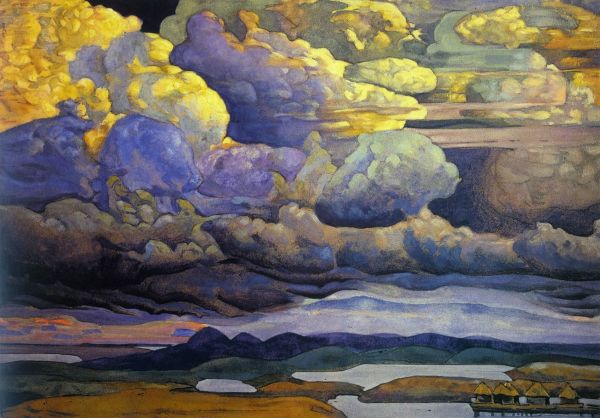|
|
Celestial Battle. 1912

Roerich Nicholas,
Tempera on cardboard
66 x 95
Annotation
Nicholas Roerich was interested in mysticism and a passionate believer in the ideas of “all-unity” and “Russocosmism”. One of his favourite motifs was the ancient north — a bleak and uninhabited land of mighty hills and cold, clear lakes. Roerich’s paintings were regarded as insights into the archaic period of Indo-European civilisation.
One of his finest works is Celestial Battle. Permeated with the divine light and “programmed” with the future history of the earth, the cumuli swirl above the distant figures of demons, messengers, knights on horseback, seafarers, sages and the silhouettes of the “prophecy stones”. Roerich portrays a hypostasis of a former golden age, when man lived in harmony with himself and the cosmos.
Author's Biography
Roerich Nicholas
Roerich, Nicholas (Nikolai Konstantinovich)
1874, St Petersburg -7, Kullu (India)
Painter, theatrical designer, writer. Studied under Arkhip Kuindzhi at the Imperial Academy of Arts (1893-97), Faculty of Law, St Petersburg University (1893-98) and Fernand Cormon''s studio in Paris (1900-01). Academician of painting (1909). Contributed to exhibitions (from 1895). Contributed to the exhibitions of the World of Art (1902, 1903, 191 1-17; founding member 1910; chairman 1910-13), Union of Russian Artists ( 1903-10; member from 1903), Salon d''Automne (1906, 1907; member from 1906), Exposition Universelle in Paris (1900), World Exhibition in St Louis (1904), International Exhibitions in Munich (1909), Rome (1911, 1914) and Malmo (1914) and the Exhibitions of Russian Art in Paris (1906-08), Berlin (1906) and Vienna (1908). Director of the School of Drawing, Society for the Encouragement of the Arts (1906-16). Designed for theatres in Moscow and St Petersburg and Sergei Diaghilev''s Saisons Russes (from 1907). Emigrated (1918). Settled in Kullu in India (1928).

